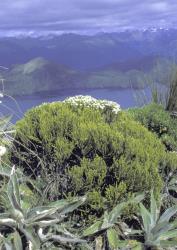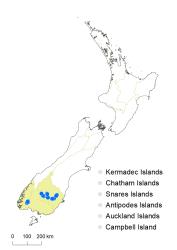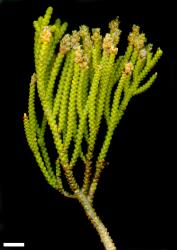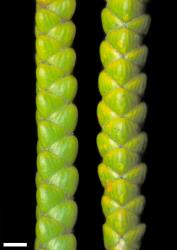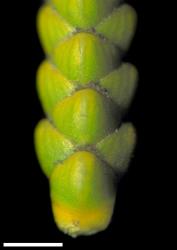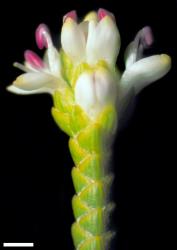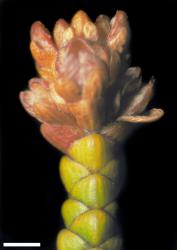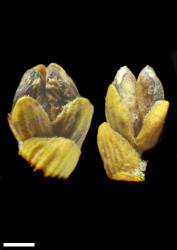- ≡ Hebe poppelwellii (Cockayne) Cockayne & Allan, Trans. New Zealand Inst. 57: 41 (1926)
- ≡ Leonohebe poppelwellii (Cockayne) Heads, Bot. Soc. Otago Newsl. 5: 9 (1987)
- ≡ Hebe imbricata subsp. poppelwelli (Cockayne) Wagstaff & Wardle, New Zealand J. Bot. 37: 33 (1999)
- = Veronica hectorii var. gracilior Petrie ex Poppelw. in Poppelwell, Trans. New Zealand Inst. 47: 140 (1915) nom. nud.
- = Veronica imbricata Petrie, Trans. & Proc. New Zealand Inst. 48: 189 (1916) nom. illeg., non Veronica imbricata Woerl. 1882
- ≡ Hebe imbricata Cockayne & Allan, Trans. New Zealand Inst. 57: 42 (1926)
- = Leonohebe imbricata (Petrie) Heads, Bot. Soc. Otago Newsl. 5: 9 (1987)
Whipcord shrub to 0.8 m tall. Stems ascending to erect, glabrous except for a tuft of eglandular hairs at connate leaf bases. Leaf bud indistinct, its outer leaves fully grown, diverging, opposite-decussate, connate in pairs and encircling stem, appressed and covering the well-marked node above, scale-like; lamina coriaceous, ovate to deltoid, 1–2 mm long, 1.6–3.0 mm wide, dull or slightly glossy green or yellowish-green above and beneath, prominently longitudinally ribbed, especially when dry; surfaces glabrous; margin shortly ciliate or ciliolate, entire, or incised on juvenile/reversion leaves; apex obtuse or sub-apiculate; base broad; petiole absent. Inflorescence a terminal spike, 3–13 mm long; flowers crowded, 6–18, all bisexual; bracts opposite-decussate and connate, ovate to deltoid; pedicels absent. Calyx lobes 4–5 (5th lobe small, posterior), obtuse to sub-acute, 2–3 mm long, sub-equal, eglandular-ciliate with long, deflexed, sinuous hairs and rare, short glandular hairs. Corolla 5–6 mm diameter; tube white, 1.7–2.5 mm long, ≤ calyx, eglandular-hairy inside; lobes 4, white, sub-erect to spreading, unequal, elliptic to orbicular, 2.3–2.8 mm long, obtuse or sometimes posterior lobe emarginate; nectar guides absent. Stamen filaments white, 2.5–4.5 mm long; anthers magenta. Style glabrous, 3.6–5.0 mm long. Capsules latiseptate, obtuse, glabrous, 2.5–3.0 mm long, 1.8–2.5 mm at widest point. Seeds ellipsoid, flattened, smooth, pale brown, 0.9–1.1 mm long.
Veronica poppelwellii plants closely resemble other whipcord hebes, in particular V. lycopodioides. V. poppelwellii and V. lycopodioides are characterised by close parallel ribbing of the leaves, prominently visible especially when dry. V. lycopodioides plants can be distinguished by their acute to apiculate leaves.
On some specimens the longitudinal ribbing on the leaves is obscure but usually still visible. The veins also differ from those of similar forms of V. hectorii in being closer to the abaxial surface and joining together to form a marginal vein.
South Island: Otago (Garvie Mountains, Old Man Range, Lammermoor and Lammerlaw Ranges, Mt Benger), Southland (Eyre Mountains, Hunter Mountains).
Penalpine grassland and low shrubland. Recorded elevations range from 915 to 1700 m.
Flowers: December–March; fruits: February–May, persisting all year.
2n = 40 (see Bayly & Kellow 2006, as Hebe imbricata).
Veronica poppelwellii is classified in V. subg. Pseudoveronica sect. Hebe and informally in the “Flagriformes” group, also known as “whipcord hebes” (Albach & Meudt 2010; Bayly & Kellow 2006). It is likely to be most closely related to V. lycopodioides, since both have pronounced longitudinal ribbing of the leaves, not seen in any other whipcord hebe.
The circumscription adopted here includes plants formerly known as Hebe imbricata from mountains between lakes Manapouri and Monowai, which differ slightly in their greener, longer, less-keeled leaves and stouter branchlets. For this circumscription, the epithet imbricata has priority under the genus Hebe (see Bayly & Kellow 2006), but the combination Veronica imbricata belongs to a northern hemisphere species and cannot be used for this one.



